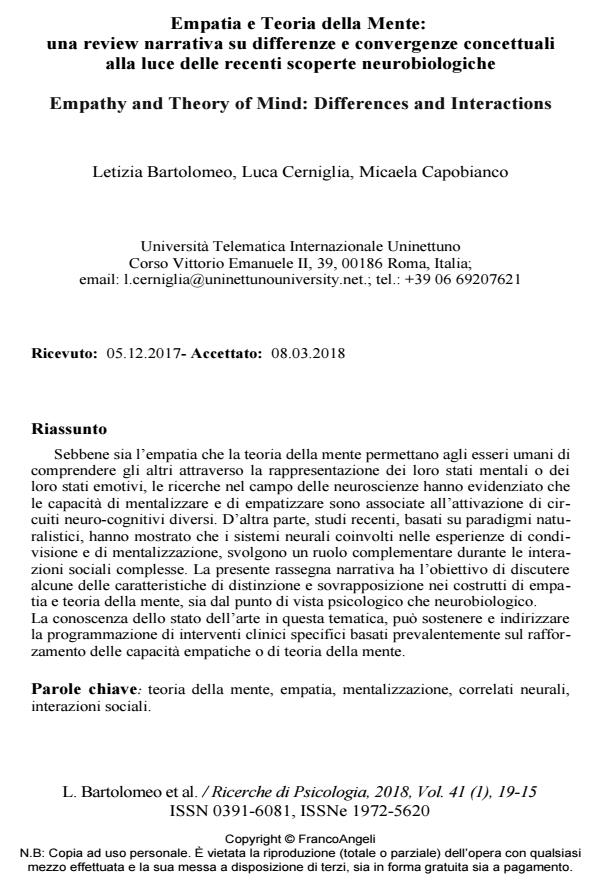Empatia e Teoria della Mente: una review narrativa su differenze e convergenze concettuali alla luce delle recenti scoperte neurobiologiche
Titolo Rivista RICERCHE DI PSICOLOGIA
Autori/Curatori Letizia Bartolomeo, Luca Cerniglia, Micaela Capobianco
Anno di pubblicazione 2018 Fascicolo 2018/1
Lingua Italiano Numero pagine 36 P. 19-54 Dimensione file 382 KB
DOI 10.3280/RIP2018-001003
Il DOI è il codice a barre della proprietà intellettuale: per saperne di più
clicca qui
Qui sotto puoi vedere in anteprima la prima pagina di questo articolo.
Se questo articolo ti interessa, lo puoi acquistare (e scaricare in formato pdf) seguendo le facili indicazioni per acquistare il download credit. Acquista Download Credits per scaricare questo Articolo in formato PDF

FrancoAngeli è membro della Publishers International Linking Association, Inc (PILA)associazione indipendente e non profit per facilitare (attraverso i servizi tecnologici implementati da CrossRef.org) l’accesso degli studiosi ai contenuti digitali nelle pubblicazioni professionali e scientifiche
Sebbene sia l’empatia che la teoria della mente permettano agli esseri umani di comprendere gli altri attraverso la rappresentazione dei loro stati mentali o dei loro stati emotivi, le ricerche nel campo delle neuroscienze hanno evidenziato che le capacità di mentalizzare e di empatizzare sono associate all’attivazione di cir-cuiti neuro-cognitivi diversi. D’altra parte, studi recenti, basati su paradigmi natu-ralistici, hanno mostrato che i sistemi neurali coinvolti nelle esperienze di condi-visione e di mentalizzazione, svolgono un ruolo complementare durante le intera-zioni sociali complesse. La presente rassegna narrativa ha l’obiettivo di discutere alcune delle caratteristiche di distinzione e sovrapposizione nei costrutti di empa-tia e teoria della mente, sia dal punto di vista psicologico che neurobiologico. La conoscenza dello stato dell’arte in questa tematica, può sostenere e indirizzare la programmazione di interventi clinici specifici basati prevalentemente sul rafforzamento delle capacità empatiche o di teoria della mente.
Parole chiave:Teoria della mente, empatia, mentalizzazione, correlati neurali, interazioni sociali.
- Communicative, cognitive and emotional issues in selective mutism Micaela Capobianco, Luca Cerniglia, in Interaction Studies. Social Behaviour and Communication in Biological and Artificial Systems /2018 pp.445
DOI: 10.1075/is.17018.cap - 2018 9th IEEE International Conference on Cognitive Infocommunications (CogInfoCom) Nicole Nascivera, Yari Mirko Alfano, Tilde Annunziato, Martina Messina, Vittoria Silviana Iorio, Valeria Cioffi, Raffaele Sperandeo, Margherita Rosato, Teresa Longobardi, Nelson Mauro Maldonato, pp.000321 (DOI:10.1109/CogInfoCom.2018.8639906)
- Socio-affective and cognitive predictors of social adaptation in vulnerable contexts Alejandra Neely-Prado, Gorka Navarrete, David Huepe, Yuka Kotozaki, in PLOS ONE /2019 pp.e0218236
DOI: 10.1371/journal.pone.0218236 - Coarticolazione temporale nelle combinazioni di gesti e parole: dati longitudinali in bambini nati a termine e pretermine nei primi due anni di età Micaela Capobianco, Luca Cerniglia, in RICERCHE DI PSICOLOGIA 2/2020 pp.547
DOI: 10.3280/RIP2020-002005
Letizia Bartolomeo, Luca Cerniglia, Micaela Capobianco, Empatia e Teoria della Mente: una review narrativa su differenze e convergenze concettuali alla luce delle recenti scoperte neurobiologiche in "RICERCHE DI PSICOLOGIA " 1/2018, pp 19-54, DOI: 10.3280/RIP2018-001003